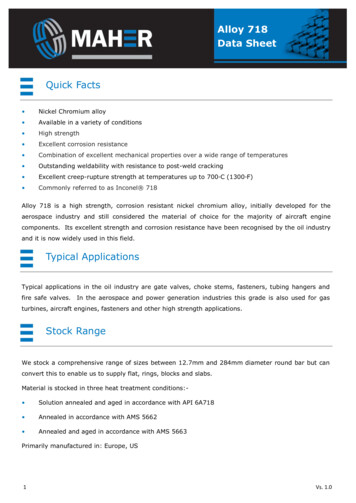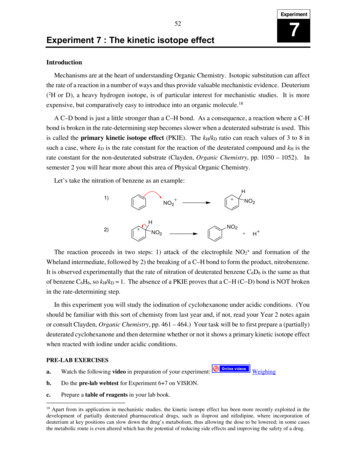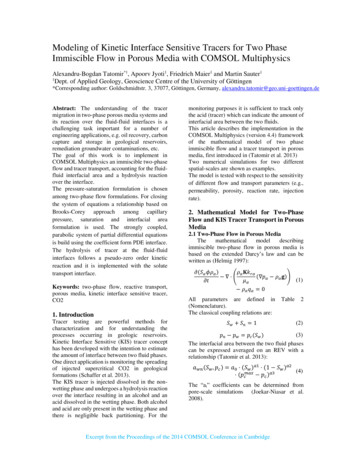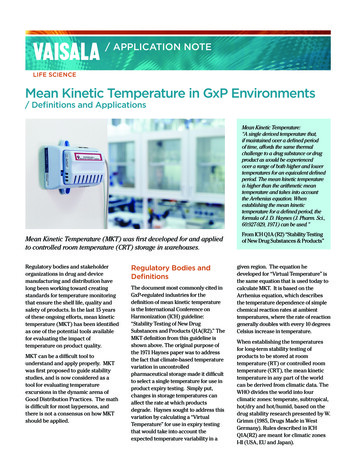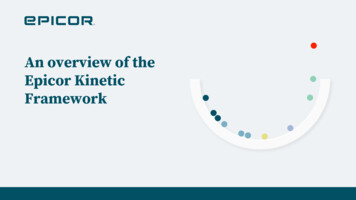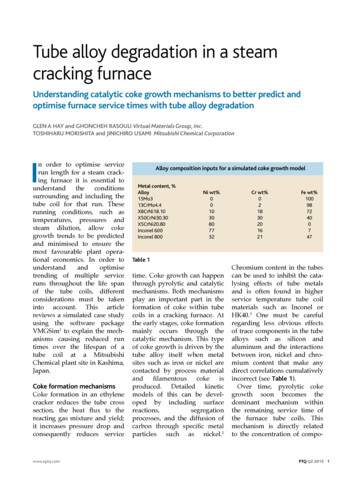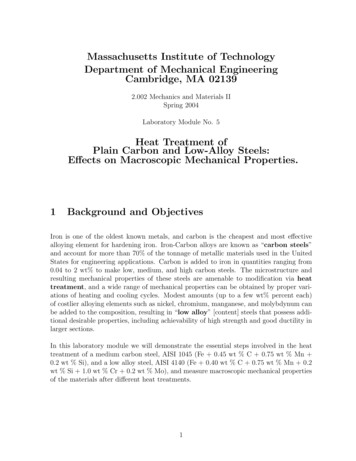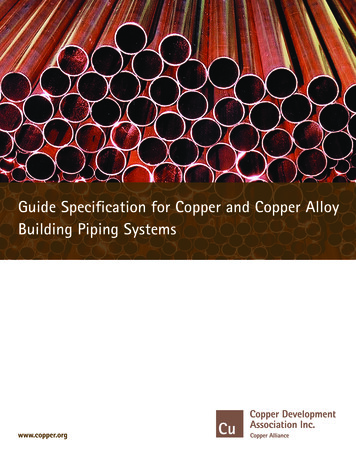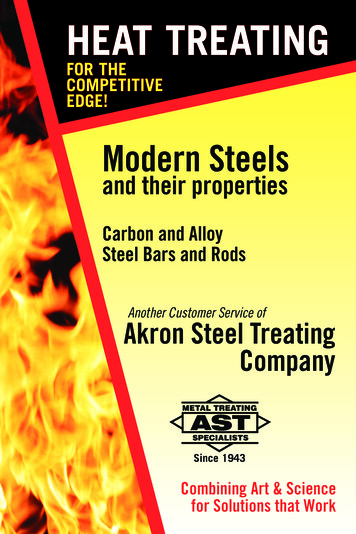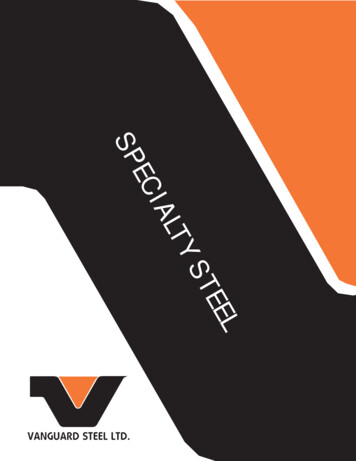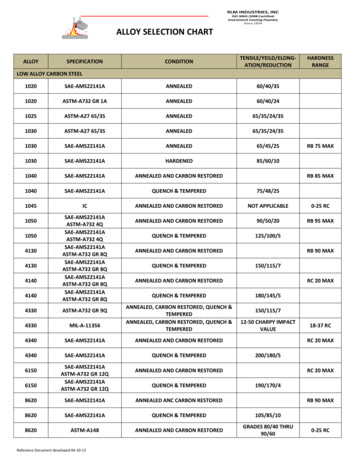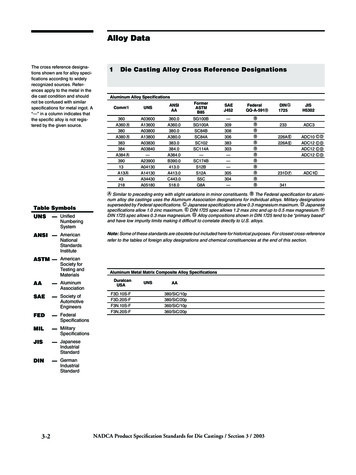
Transcription
Alloy DataThe cross reference designations shown are for alloy specifications according to widelyrecognized sources. References apply to the metal in thedie cast condition and shouldnot be confused with similarspecifications for metal ingot. A“—” in a column indicates thatthe specific alloy is not registered by the given source.Table SymbolsUNS— UnifiedNumberingSystemANSI — AmericanNationalStandardsInstitute1Die Casting Alloy Cross Reference DesignationsTable 3-1Aluminum Alloy �—305304—FederalQQ-A-591Table 3-2Aluminum Metal Matrix Composite Alloy Specifications— AluminumDuralcanUSASAE— Society ofFED— FederalF3D.10S-FF3D.20S-FF3N.10S-FF3N.20S-FMIL— MilitaryJIS— JapaneseDIN— C12ADC12ADC12231DADC1341Note: Some of these standards are obsolete but included here for historical purposes. For closest cross-referencerefer to the tables of foreign alloy designations and chemical constituencies at the end of this section.AAAssociationJISH5302Similar to preceding entry with slight variations in minor constituents.The Federal specification for aluminum alloy die castings uses the Aluminum Association designations for individual alloys. Military designationssuperseded by Federal specifications. Japanese specifications allow 0.3 magnesium maximum. Japanesespecifications allow 1.0 zinc maximum. DIN 1725 spec allows 1.2 max zinc and up to 0.5 max magnesium.DIN 1725 spec allows 0.3 max magnesium. Alloy compositions shown in DIN 1725 tend to be “primary based”and have low impurity limits making it difficult to correlate directly to U.S. alloys.ASTM — AmericanSociety forTesting strialStandardIndustrialStandardNADCA Product Specification Standards for Die Castings / Section 3 / 2003
Alloy DataTable 3-3Copper Alloy 0A—ZS144A———J462—J462——3Table 3-4Magnesium Alloy SpecificationsComm'lUNSASTMB93 &B94FormerSAEJ465BFederalDIN1729JISH2222 �—MDI1BMDI1D—MDI2AMDI2B——MDI3A——Table SymbolsUNS— UnifiedNumberingSystemANSI — AmericanNationalStandardsInstituteASTM — AmericanSociety forTesting andMaterialsTable 3-5Zinc and ZA Alloy ��174317431743JISZDC-2ZDC-1NADCA Product Specification Standards for Die Castings / Section 3 / 2003AA— AluminumSAE— Society ofFED— FederalMIL— MilitaryJIS— JapaneseDIN— 3-3
Alloy Data : Aluminum Die Casting Alloys2SelectingAluminum AlloysAluminum (Al) die casting alloys havea specific gravity of approximately 2.7g/cc, placing them among the lightweightstructural metals. The majority of die castings produced worldwide are made fromaluminum alloys.Six major elements constitute the die castaluminum alloy system: silicon, copper,magnesium, iron, manganese, and zinc.Each element affects the alloy both independently and interactively.This aluminum alloy subsection presentsguideline tables for chemical composition,typical properties, and die casting, machining and finishing characteristics for 11aluminum die casting alloys. This data canbe used in combination with design engineering tolerancing guidelines for aluminumdie casting and can be compared with theguidelines for other alloys in this sectionand in the design engineering section.Alloy A380 (ANSI/AA A380.0) is by farthe most widely cast of the aluminum diecasting alloys, offering the best combinationof material properties and ease of production. It may be specified for most productapplications. Some of the uses of this alloyinclude electronic and communicationsequipment, automotive components, enginebrackets, transmission and gear cases,appliances, lawn mower housings, furniturecomponents, hand and power tools.Alloy 383 (ANSI/AA 383.0) and alloy 384(ANSI/AA 384.0) are alternatives to A380for intricate components requiring improveddie filling characteristics. Alloy 383 offersimproved resistance to hot cracking(strength at elevated temperatures).Alloy A360 (ANSI/AA A360.0) offers highercorrosion resistance, superior strength atelevated temperatures, and somewhat betterductility, but is more difficult to cast.While not in wide use and difficult tocast, alloy 43 (ANSI/AA C443.0) offers thehighest ductility in the aluminum family. It ismoderate in corrosion resistance and oftencan be used in marine grade applications.Alloy A13 (ANSI/AA A413.0) offers excellent pressure tightness, making it a goodchoice for hydraulic cylinders and pressurevessels. Its casting characteristics make it3-4useful for intricate components.Alloy 390 (ANSI/AA B390.0) was developed for automotive engine blocks. Itsresistance to wear is excellent; its ductility islow. It is used for die cast valve bodies andcompressor housings in pistons.Alloy 218 (ANSI/AA 518.0) provides thebest combination of strength, ductility, corrosion resistance and finishing qualities, butit is more difficult to die cast.Machining CharacteristicsMachining characteristics vary somewhatamong the commercially available aluminum die casting alloys, but the entiregroup is superior to iron, steel and titanium. The rapid solidification rate associated with the die casting process makesdie casting alloys somewhat superior towrought and gravity cast alloys of similarchemical composition.Alloy A380 has better than averagemachining characteristics. Alloy 218, withmagnesium the major alloying element,exhibits among the best machinability. Alloy390, with the highest silicon content and freesilicon constituent, exhibits the lowest.Surface Treatment SystemsSurface treatment systems are applied toaluminum die castings to provide a decorative finish, to form a protective barrieragainst environmental exposure, and toimprove resistance to wear.Decorative finishes can be applied toaluminum die castings through painting,powder coat finishing, polishing, epoxyfinishing, and plating. Aluminum can beplated by applying an initial immersion zinccoating, followed by conventional coppernickel-chromium plating procedure similar tothat used for plating zinc metal/alloys.Protection against environmental corrosion for aluminum die castings is achievedthrough painting, anodizing, chromating,and iridite coatings.Improved wear resistance can beachieved with aluminum die castings byhard anodizing.Where a part design does not allow theproduction of a pressure-tight die casting through control of porosity by gate andoverflow die design, the location of ejectorpins, and the reconfiguration of hard-tocast features, impregnation of aluminumdie castings can be used. Systems employ-NADCA Product Specification Standards for Die Castings / Section 3 / 2003
Alloy Data : Aluminum Die Casting Alloy CompositionNADCAA-3-1-03Standarding anaerobics and methacrylates areemployed to produce sealed, pressure-tightcastings with smooth surfaces.A detailed discussion of finishing methodsfor aluminum die castings can be found inProduct Design For Die Casting. Analysis shall ordinarily be made only for the elements mentioned in this table. If, however, the presence of other elements is suspected, or indicated in the course of routine analysis, further analysis shall be made to determine that the total of these other elements are not present in excess ofspecified limits. With respect to mechanical properties, alloys A380.0, 383.0 and 384.0 are substantially interchangeable. Sources: ASTM B85-92a;Aluminum Association.* Two other aluminum alloys, 361 & 369, are being utilized in limited applications where vibration and wear are of concern. Contact your alloy producerfor more information.NADCA Product Specification Standards for Die Castings / Section 3 / 20033-53
Alloy Data : Aluminum Die Casting Alloy PropertiesNADCAA-3-2-03Standard 0.2% offset. 500 kg load, 10mm ball.Rotary Bend 5 x 108 cyclesNotched Charpy. Sources: ASTM B85-92a; ASM; SAE; Wabash Alloys.* Two other aluminum alloys, 361 & 369, are being utilized in limited applications where vibration and wear are of concern. Contact your alloy producerfor more information.More info can be obtained from Microstructure and Properties of Aluminum Die Casting Alloys Book, NADCA Publication # 2153-6NADCA Product Specification Standards for Die Castings / Section 3 / 2003
Alloy Data : Aluminum Die Casting Alloy CharacteristicsNADCAA-3-3-03GuidelinesDie casting alloy selection requires evaluationnot only of physical and mechanical properties, and chemical composition, but also ofinherent alloy characteristics and their effecton die casting production as well as possiblemachining and final surface finishing.This table includes selected die castingand other special characteristics which areusually considered in selecting an aluminumalloy for a specific application.The characteristics are rated from (1) to(5), (1) being the most desirable and (5)being the least. In applying these ratings, itshould be noted that all the alloys have sufficiently good characteristics to be acceptedby users and producers of die castings. Arating of (5) in one or more categories wouldnot rule out an alloy if other attributes areparticularly favorable, but ratings of (5) maypresent manufacturing difficulties.The benefits of consulting a custom diecaster experienced in casting the aluminumalloy being considered are clear.Table A-3-3 Die Casting and Other Characteristics: Al Alloys3(1 most desirable, 5 least desirable)Aluminum Die Casting AlloysCommercial:ANSI/AA:Resistance toHot olderingto the DieCorrosionResistanceMachiningEase & QualityPolishingEase & QualityElectroplatingEase & QualityAnodizing(Appearance)Chemical OxideProtective CoatingStrength atElevated 44455332111332233354Ability of alloy to withstand stresses from contraction while cooling through hot-short or brittle temperatureranges. Ability of molten alloy to flow readily in die and fill thin sections. Ability of molten alloy to flow withoutsticking to the die surfaces. Ratings given for anti-soldering are based on nominal iron compositions of approximately 1%.Based on resistance of alloy in st
ASTM B85 SAE J452 Federal QQ-A-591 DIN 1725 JIS H5302 360 A03600 360.0 SG100B — A360 A13600 A360.0 SG100A 309 233 ADC3 380 A03800 380.0 SC84B 308 A380 A13800 A380.0 SC84A 306 226A ADC10 383 A03830 383.0 SC102 383 226A ADC12 384 A03840 384.0 SC114A 303 ADC12 A384 — A384.0 — — ADC12 390 A23900 B390.0 SC174B — 13 A04130 413.0 S12B — A13 A14130 File Size: 512KBPage Count: 18
